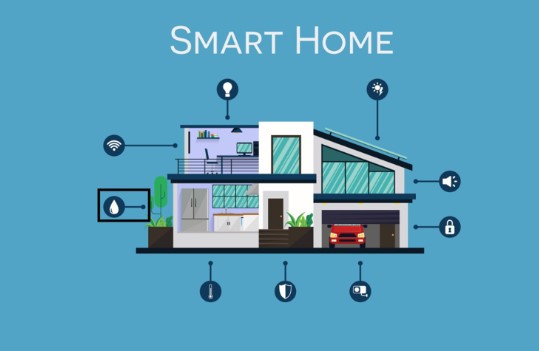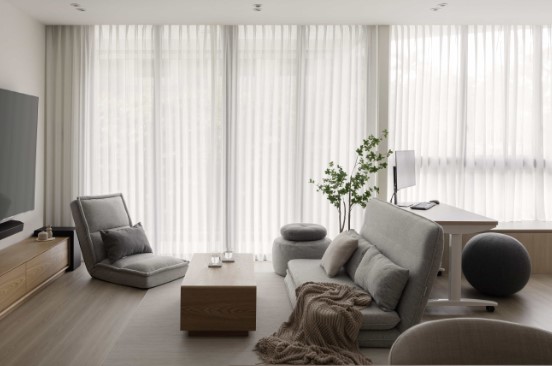Smart Home Design: Integrating Technology for Modern Living
Smart home design has become an integral part of modern living, blending technology and convenience to create a more comfortable and efficient lifestyle. As we move further into the digital age, the integration of smart devices and systems in our homes has gone from a luxury to a necessity. The demand for smart home technologies is driven by the promise of enhanced convenience, energy efficiency, and security. In this comprehensive guide, we will explore the latest trends in smart home design, delve into the benefits of these technologies, and provide detailed information on some of the top products available in the market.
Understanding Smart Home Design

Smart home design is a holistic approach to integrating technology into our living spaces. It encompasses various systems and devices that work together to automate and control different aspects of the home environment. The core concept revolves around connectivity, where devices communicate with each other and can be controlled remotely or through voice commands. This integration allows homeowners to manage their homes more efficiently, whether it’s adjusting the thermostat, turning off lights, or monitoring security cameras.
Components of a Smart Home
Smart home systems can vary widely depending on the specific needs and preferences of the homeowner. However, several key components are commonly found in most smart homes:
- Smart Lighting Systems: These systems allow users to control the lighting in their homes remotely. They offer features like dimming, color changing, and scheduling, which can be customized to fit different moods and occasions. Smart lighting not only enhances the aesthetic appeal of a home but also contributes to energy savings.
- Smart Security Systems: Security is a top priority for many homeowners. Smart security systems include cameras, sensors, alarms, and smart locks, all of which can be monitored and controlled remotely. These systems provide real-time alerts and can be integrated with other smart home devices for a comprehensive security solution.
- Smart Thermostats: Smart thermostats are designed to optimize heating and cooling systems, helping homeowners save on energy costs. They learn the household’s schedule and adjust the temperature accordingly. Many smart thermostats can also be controlled via smartphone apps or voice commands.
- Smart Appliances: From refrigerators that can order groceries to ovens that can be preheated remotely, smart appliances bring a new level of convenience to the kitchen. These devices are often compatible with voice assistants, allowing for hands-free operation.
- Smart Entertainment Systems: These systems include smart TVs, speakers, and streaming devices that offer high-quality audio and video experiences. They can be controlled through a central hub or smartphone app, making it easy to access various entertainment options.
The Evolution of Smart Home Technology
The concept of smart homes has been around for several decades, but it has only recently become mainstream. The rapid advancement of technology, coupled with the increasing availability of high-speed internet, has made it possible for more people to enjoy the benefits of smart home systems. In the past, smart home technologies were primarily available to affluent consumers. However, with the proliferation of affordable devices and the rise of DIY solutions, smart home design has become accessible to a broader audience.
Benefits of Smart Home Design
The adoption of smart home technologies offers numerous benefits, making it an attractive option for homeowners. These benefits can be categorized into several key areas:
Convenience and Automation
One of the primary advantages of smart home design is the convenience it offers. By automating various tasks, smart home systems reduce the need for manual intervention, allowing homeowners to focus on more important activities. For example, smart lighting systems can be programmed to turn on and off based on the time of day or occupancy, eliminating the need to manually switch lights. Similarly, smart thermostats can adjust the temperature based on the weather or the homeowner’s schedule, ensuring a comfortable environment without the need for constant adjustments.
Energy Efficiency and Cost Savings
Smart home technologies are designed to be energy-efficient, helping homeowners reduce their energy consumption and save money on utility bills. For instance, smart thermostats can learn the household’s schedule and adjust the heating and cooling accordingly, minimizing energy waste. Smart lighting systems can also be set to turn off when no one is in the room, further reducing energy usage. Additionally, some smart home systems provide energy usage reports, allowing homeowners to monitor their consumption and make informed decisions to improve efficiency.
Enhanced Security and Safety
Security is a significant concern for many homeowners, and smart home systems offer advanced solutions to enhance safety. Smart security systems include features like real-time monitoring, motion detection, and remote access, allowing homeowners to keep an eye on their property from anywhere. For example, smart cameras can send alerts to the homeowner’s smartphone if they detect suspicious activity, while smart locks can be controlled remotely to grant or restrict access. These features not only provide peace of mind but also act as a deterrent to potential intruders.
Improved Comfort and Lifestyle
Smart home systems can significantly improve the overall comfort and lifestyle of homeowners. For instance, smart lighting can create the perfect ambiance for different activities, whether it’s watching a movie, reading a book, or hosting a dinner party. Smart thermostats ensure that the home is always at the ideal temperature, while smart appliances make household chores easier and more efficient. By integrating these technologies, homeowners can create a personalized living environment that caters to their unique needs and preferences.
Accessibility and Independence
For individuals with mobility issues or disabilities, smart home technologies can provide greater accessibility and independence. Voice-controlled devices, for example, allow users to operate various systems without the need for physical interaction. This can be particularly beneficial for the elderly or those with limited mobility, as it enables them to control their environment more easily. Smart home systems can also include features like automated door openers and smart doorbells, which further enhance accessibility.
Top Smart Home Products in 2024
As the smart home market continues to grow, numerous products are available to cater to different needs and preferences. Here are some of the top smart home products in 2024, along with detailed information about their features, benefits, and use cases.
1. Control4 Smart Home System
The Control4 Smart Home System is a comprehensive solution that integrates lighting, audio, video, security, and more into a single, cohesive system. It offers a user-friendly interface and supports voice control through popular assistants like Amazon Alexa and Google Assistant. The system is highly customizable, allowing homeowners to tailor it to their specific needs.
- Features: Integrated control, voice assistant compatibility, customizable scenes
- Pros: Customizable, supports a wide range of devices, intuitive interface
- Cons: High installation costs, may require professional setup
- Price: Starting at $1,500
2. Google Nest Hub Max
The Google Nest Hub Max is a versatile smart display that serves as the central hub for your smart home. It offers hands-free control, video calling, and can display real-time footage from compatible security cameras. The device also features a high-quality speaker and can be used to stream music or watch videos.
- Features: Voice assistant, smart home control, video calling
- Pros: Versatile functions, easy setup, excellent video quality
- Cons: Limited compatibility with non-Google devices
- Price: $229
3. Philips Hue Smart Lighting
Philips Hue offers a wide range of smart lighting options, including bulbs, light strips, and lamps. These products can be controlled via smartphone or voice commands, allowing users to customize their lighting experience. Philips Hue lights can also be synced with music, movies, and games, creating an immersive atmosphere.
- Features: Color-changing, voice control, integration with smart home systems
- Pros: Wide range of products, customizable, energy-efficient
- Cons: Requires a hub, can be expensive
- Price: Starting at $69.99
4. Ring Video Doorbell Pro
The Ring Video Doorbell Pro is a smart doorbell that enhances home security with features like HD video, two-way talk, and motion detection. It connects to your smartphone, allowing you to see and communicate with visitors from anywhere. The device also offers customizable motion zones and can send real-time alerts.
- Features: HD video, two-way communication, motion detection
- Pros: High-quality video, two-way audio, motion alerts
- Cons: Requires subscription for advanced features
- Price: $249
5. Ecobee SmartThermostat
The Ecobee SmartThermostat is an advanced temperature control device that offers features like room sensors, voice control, and energy reports. It integrates with various smart home systems, including Apple HomeKit, Amazon Alexa, and Google Assistant. The thermostat can learn your schedule and preferences, optimizing energy use for maximum efficiency.
- Features: Room sensors, voice control, energy reports
- Pros: Energy-efficient, easy to use, voice control
- Cons: Initial setup can be complex
- Price: $249
Comparison Table
| Product Name | Use Case | Pros | Cons | Price | Features |
|---|---|---|---|---|---|
| Control4 Smart Home System | Comprehensive Home | Customizable, wide device support | High installation costs | $1,500+ | Integrated control, customizable scenes |
| Google Nest Hub Max | Central Hub | Versatile functions, video quality | Limited compatibility | $229 | Voice assistant, smart home control |
| Philips Hue Smart Lighting | Lighting | Customizable, energy-efficient | Requires a hub, can be expensive | $69.99+ | Color-changing, sync with entertainment |
| Ring Video Doorbell Pro | Security | High-quality video, two-way audio | Subscription needed for full features | $249 | HD video, motion detection |
| Ecobee SmartThermostat | Temperature Control | Energy-efficient, voice control | Initial setup can be complex | $249 | Room sensors, energy reports |
How to Choose the Right Smart Home Products
Selecting the right smart home products can be a daunting task given the plethora of options available. Here are some factors to consider when making your choice:
Compatibility
Ensure that the smart home devices you choose are compatible with each other and any existing systems you have in place. Compatibility is crucial for creating a seamless and integrated smart home experience. For instance, if you already have a Google Nest Hub Max, you may want to choose other Google-compatible devices.
Features
Consider the features that are most important to you. Whether it’s energy efficiency, security, or entertainment, prioritize products that offer the features that will enhance your lifestyle. For example, if security is a top priority, investing in a robust smart security system like the Ring Video Doorbell Pro would be a wise choice.
Budget
Smart home products can vary significantly in price, so it’s essential to set a budget and stick to it. While some devices, like the Control4 Smart Home System, can be expensive, others, like Philips Hue lights, offer more affordable options. Consider the long-term savings that certain products, like smart thermostats, can provide when calculating your budget.
Ease of Use
The user-friendliness of smart home products is another critical factor to consider. Look for devices with intuitive interfaces and easy installation processes. Products that require professional setup may add to the overall cost, so keep that in mind when making your decision.
Where to Buy Smart Home Products
Smart home products are widely available, both online and in physical stores. Here are some popular platforms where you can purchase these devices:
- Amazon: Amazon offers a vast selection of smart home products, often at competitive prices. The platform also provides customer reviews and ratings, making it easier to choose the right product.
- Best Buy: Best Buy has a comprehensive selection of smart home devices and offers the option to see products in person before purchasing. They also provide professional installation services.
- Home Depot: Home Depot is another excellent option for purchasing smart home products. They offer a wide range of devices and often have sales and discounts.
- Manufacturer Websites: Buying directly from the manufacturer’s website, such as Control4, Google, or Philips Hue, can be a good option if you’re looking for specific products or exclusive deals.
Detailed Use Cases
Energy Management
One of the most significant advantages of smart home systems is their ability to manage energy consumption efficiently. Smart thermostats like the Ecobee SmartThermostat can learn your schedule and preferences, adjusting the temperature accordingly. This not only ensures comfort but also reduces energy waste. Additionally, smart lighting systems like Philips Hue can be programmed to turn off when no one is in the room, further saving energy.
Enhanced Security
Smart home security systems offer a range of features designed to protect your home. For example, the Ring Video Doorbell Pro provides real-time video footage and two-way communication, allowing you to interact with visitors even when you’re not home. Smart locks can be controlled remotely, providing access to trusted individuals while keeping unwanted visitors out.
Convenience and Automation
Smart home systems offer unparalleled convenience by automating routine tasks. For instance, smart speakers and hubs like the Google Nest Hub Max can control multiple devices with simple voice commands. You can set up routines that adjust lighting, temperature, and security settings at specific times or when certain conditions are met.
Health and Wellness
Smart home devices can also contribute to health and wellness. Air quality monitors can detect pollutants and allergens, while smart lighting can be adjusted to promote better sleep. Smart speakers can provide guided meditation, workout routines, and even remind you to take medications.
Entertainment
Smart home entertainment systems offer a rich multimedia experience. Smart TVs, speakers, and streaming devices can be integrated to provide seamless access to your favorite shows, movies, and music. You can also create customized lighting and sound settings for different activities, such as movie nights or parties.
Frequently Asked Questions
1. What is the best smart home system?
The best smart home system depends on your needs and budget. Control4 offers a comprehensive solution, but it can be expensive. Google Nest Hub Max is a versatile and affordable option.
2. Are smart home devices secure?
Most smart home devices offer strong security features, but it’s essential to keep your software updated and use strong passwords.
3. Can I install smart home devices myself?
Many smart home devices, like smart lights and thermostats, are easy to install. However, more complex systems like Control4 may require professional installation.
4. How much does it cost to set up a smart home?
The cost varies widely depending on the products and features you choose. Basic setups can start at a few hundred dollars, while comprehensive systems can cost several thousand.
5. What are the benefits of smart home automation?
Smart home automation offers convenience, energy efficiency, enhanced security, and the ability to control your home remotely.






